sensor JEEP RENEGADE 2017 1.G Owners Manual
[x] Cancel search | Manufacturer: JEEP, Model Year: 2017, Model line: RENEGADE, Model: JEEP RENEGADE 2017 1.GPages: 516, PDF Size: 5.73 MB
Page 52 of 516
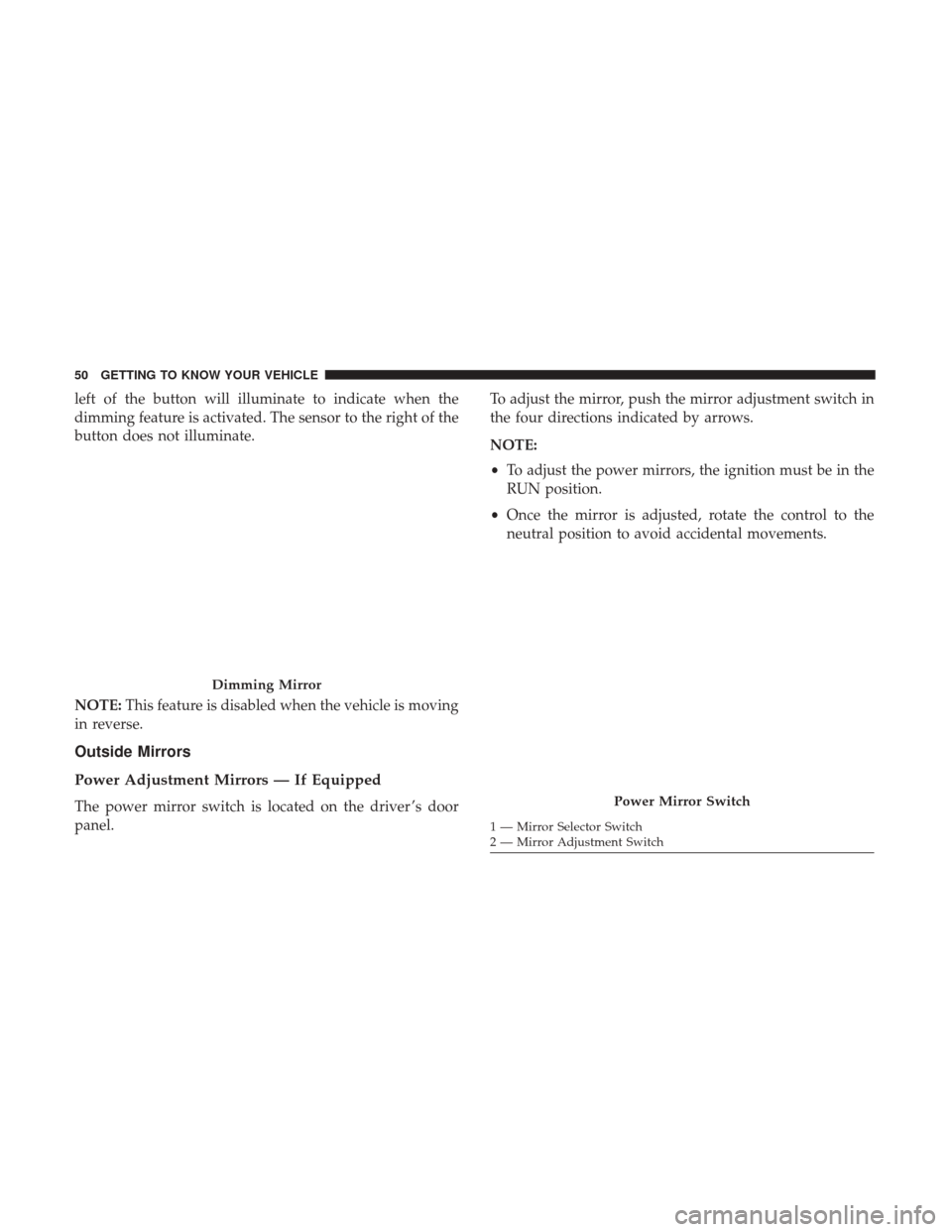
left of the button will illuminate to indicate when the
dimming feature is activated. The sensor to the right of the
button does not illuminate.
NOTE:This feature is disabled when the vehicle is moving
in reverse.
Outside Mirrors
Power Adjustment Mirrors — If Equipped
The power mirror switch is located on the driver ’s door
panel. To adjust the mirror, push the mirror adjustment switch in
the four directions indicated by arrows.
NOTE:
•
To adjust the power mirrors, the ignition must be in the
RUN position.
• Once the mirror is adjusted, rotate the control to the
neutral position to avoid accidental movements.
Dimming Mirror
Power Mirror Switch
1 — Mirror Selector Switch
2 — Mirror Adjustment Switch
50 GETTING TO KNOW YOUR VEHICLE
Page 55 of 516
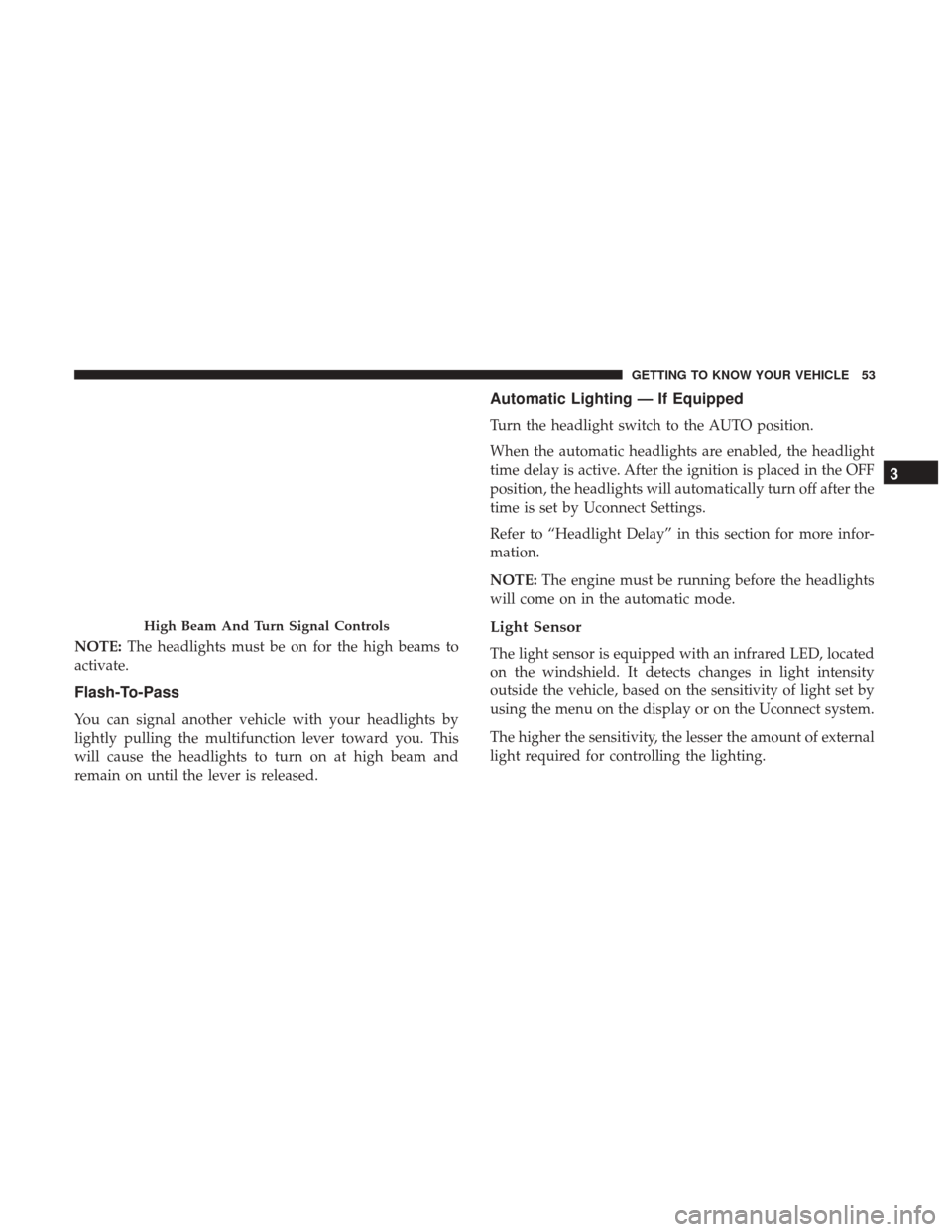
NOTE:The headlights must be on for the high beams to
activate.
Flash-To-Pass
You can signal another vehicle with your headlights by
lightly pulling the multifunction lever toward you. This
will cause the headlights to turn on at high beam and
remain on until the lever is released.
Automatic Lighting — If Equipped
Turn the headlight switch to the AUTO position.
When the automatic headlights are enabled, the headlight
time delay is active. After the ignition is placed in the OFF
position, the headlights will automatically turn off after the
time is set by Uconnect Settings.
Refer to “Headlight Delay” in this section for more infor-
mation.
NOTE: The engine must be running before the headlights
will come on in the automatic mode.
Light Sensor
The light sensor is equipped with an infrared LED, located
on the windshield. It detects changes in light intensity
outside the vehicle, based on the sensitivity of light set by
using the menu on the display or on the Uconnect system.
The higher the sensitivity, the lesser the amount of external
light required for controlling the lighting.
High Beam And Turn Signal Controls
3
GETTING TO KNOW YOUR VEHICLE 53
Page 65 of 516
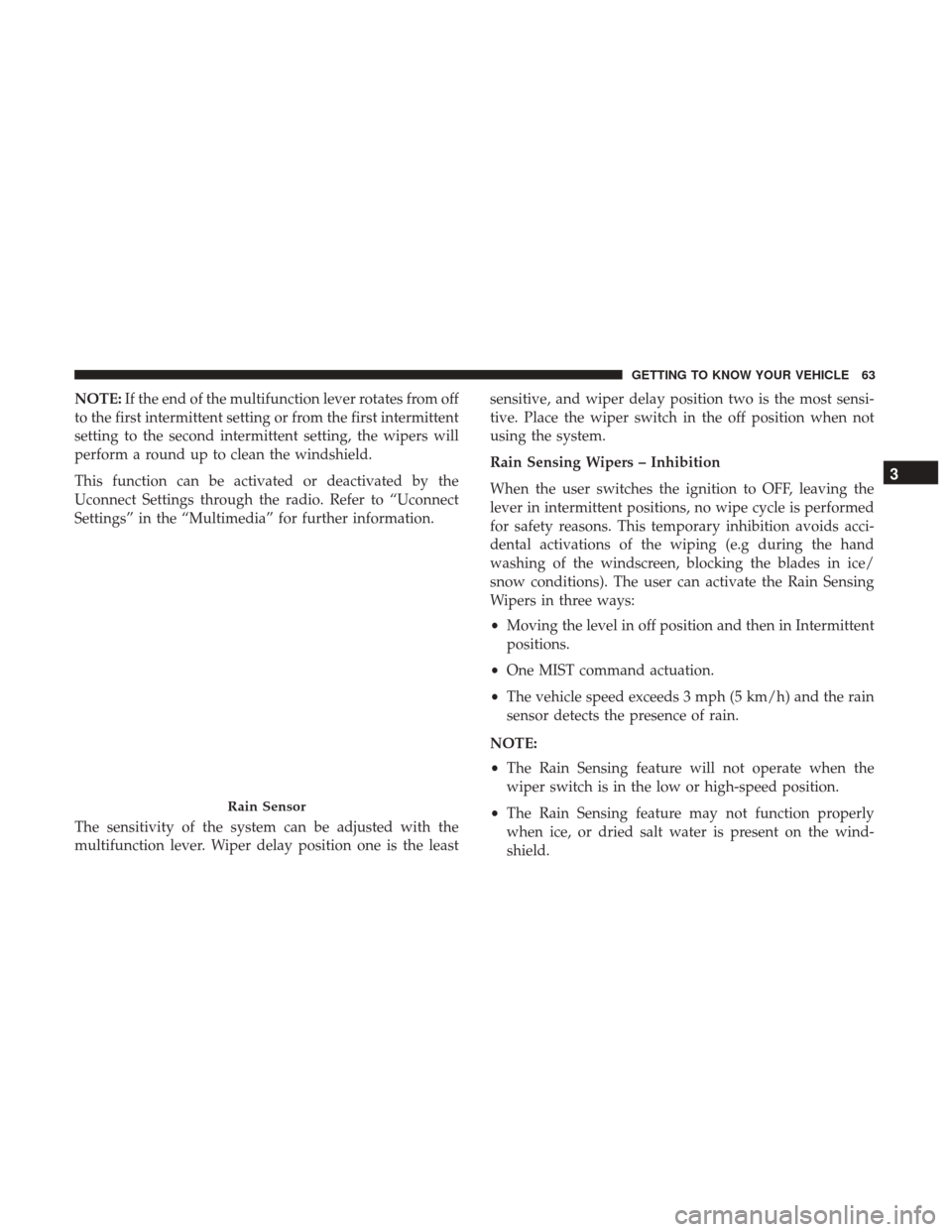
NOTE:If the end of the multifunction lever rotates from off
to the first intermittent setting or from the first intermittent
setting to the second intermittent setting, the wipers will
perform a round up to clean the windshield.
This function can be activated or deactivated by the
Uconnect Settings through the radio. Refer to “Uconnect
Settings” in the “Multimedia” for further information.
The sensitivity of the system can be adjusted with the
multifunction lever. Wiper delay position one is the least sensitive, and wiper delay position two is the most sensi-
tive. Place the wiper switch in the off position when not
using the system.
Rain Sensing Wipers – Inhibition
When the user switches the ignition to OFF, leaving the
lever in intermittent positions, no wipe cycle is performed
for safety reasons. This temporary inhibition avoids acci-
dental activations of the wiping (e.g during the hand
washing of the windscreen, blocking the blades in ice/
snow conditions). The user can activate the Rain Sensing
Wipers in three ways:
•
Moving the level in off position and then in Intermittent
positions.
• One MIST command actuation.
• The vehicle speed exceeds 3 mph (5 km/h) and the rain
sensor detects the presence of rain.
NOTE:
• The Rain Sensing feature will not operate when the
wiper switch is in the low or high-speed position.
• The Rain Sensing feature may not function properly
when ice, or dried salt water is present on the wind-
shield.
Rain Sensor
3
GETTING TO KNOW YOUR VEHICLE 63
Page 141 of 516
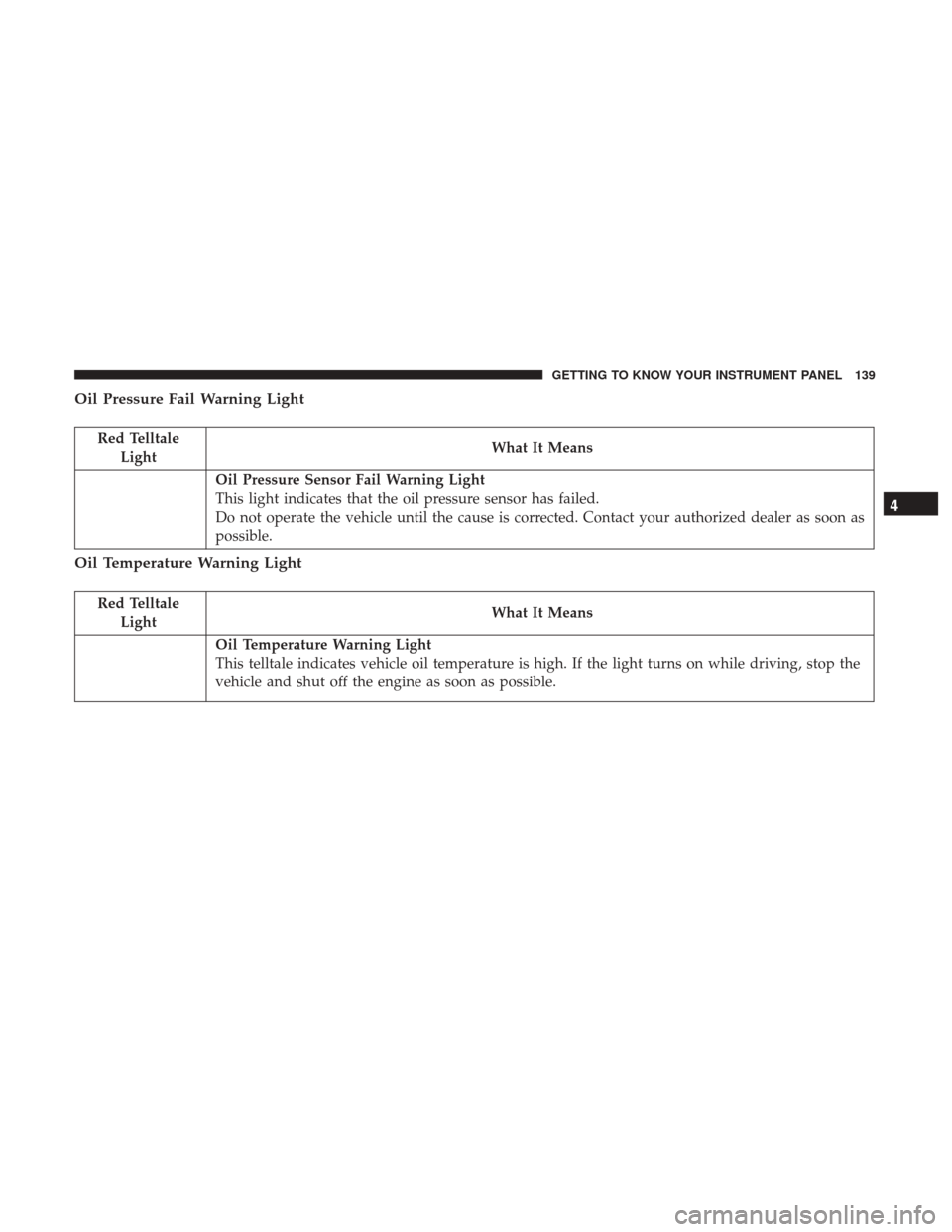
Oil Pressure Fail Warning Light
Red TelltaleLight What It Means
Oil Pressure Sensor Fail Warning Light
This light indicates that the oil pressure sensor has failed.
Do not operate the vehicle until the cause is corrected. Contact your authorized dealer as soon as
possible.
Oil Temperature Warning Light
Red Telltale
Light What It Means
Oil Temperature Warning Light
This telltale indicates vehicle oil temperature is high. If the light turns on while driving, stop the
vehicle and shut off the engine as soon as possible.
4
GETTING TO KNOW YOUR INSTRUMENT PANEL 139
Page 146 of 516
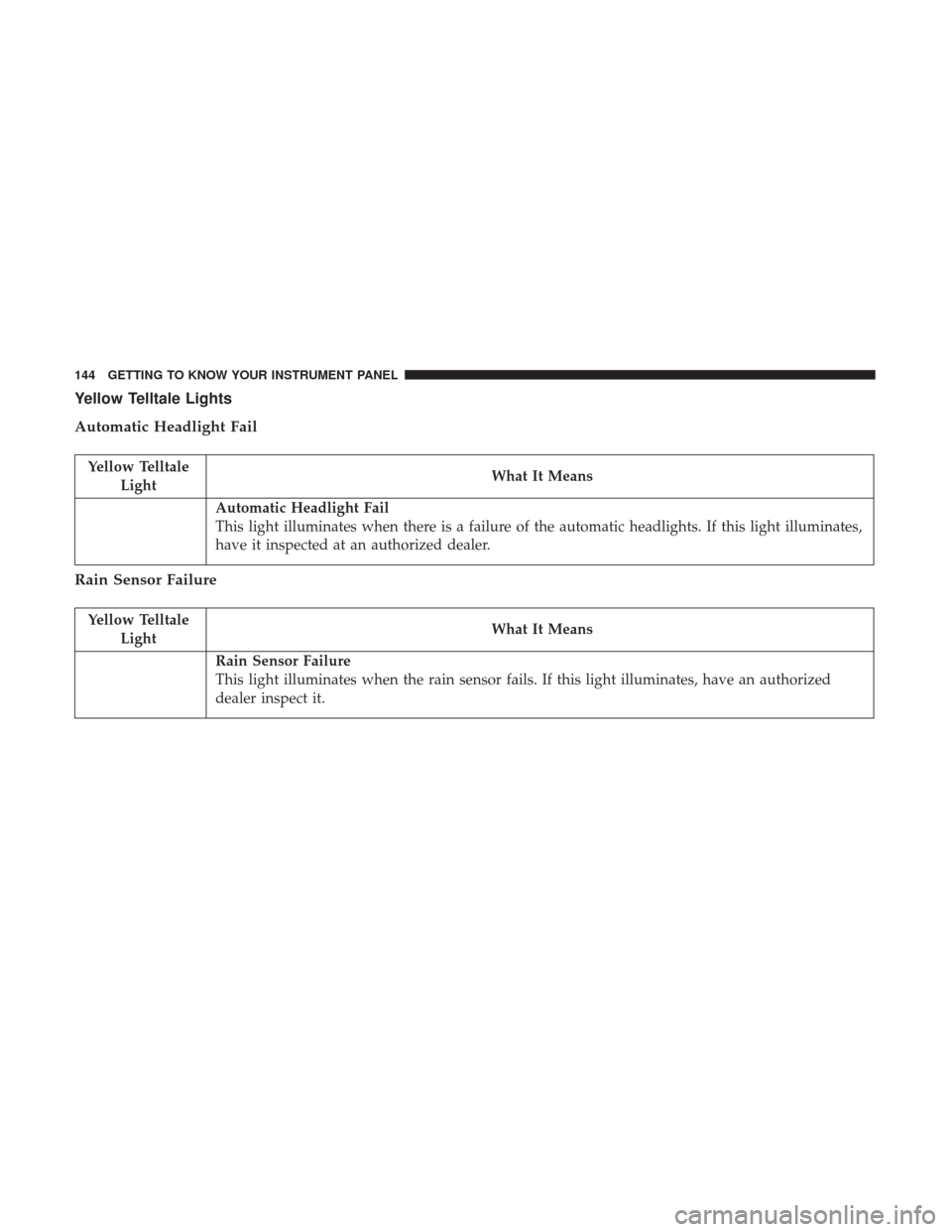
Yellow Telltale Lights
Automatic Headlight Fail
Yellow TelltaleLight What It Means
Automatic Headlight Fail
This light illuminates when there is a failure of the automatic headlights. If this light illuminates,
have it inspected at an authorized dealer.
Rain Sensor Failure
Yellow Telltale
Light What It Means
Rain Sensor Failure
This light illuminates when the rain sensor fails. If this light illuminates, have an authorized
dealer inspect it.
144 GETTING TO KNOW YOUR INSTRUMENT PANEL
Page 149 of 516
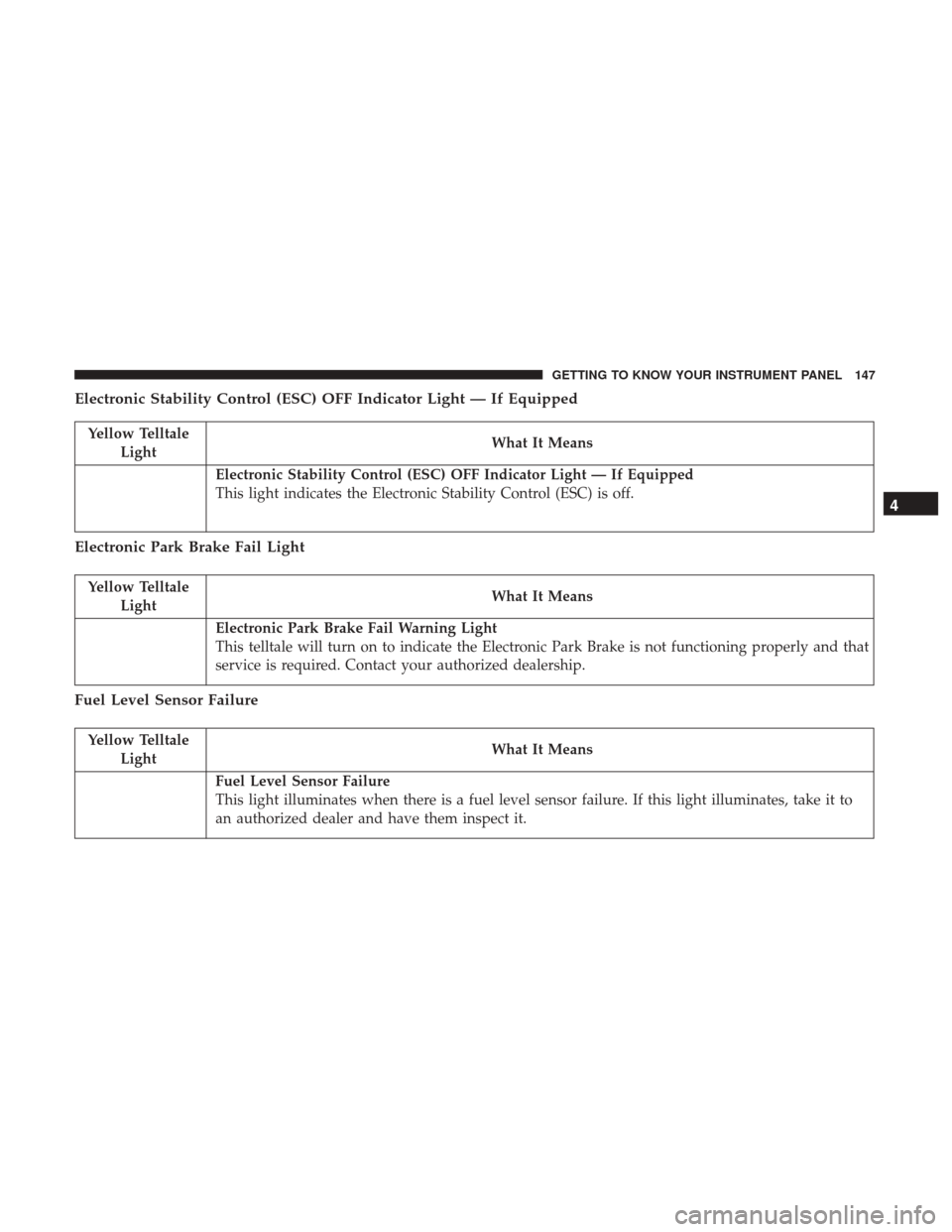
Electronic Stability Control (ESC) OFF Indicator Light — If Equipped
Yellow TelltaleLight What It Means
Electronic Stability Control (ESC) OFF Indicator Light — If Equipped
This light indicates the Electronic Stability Control (ESC) is off.
Electronic Park Brake Fail Light
Yellow Telltale
Light What It Means
Electronic Park Brake Fail Warning Light
This telltale will turn on to indicate the Electronic Park Brake is not functioning properly and that
service is required. Contact your authorized dealership.
Fuel Level Sensor Failure
Yellow Telltale
Light What It Means
Fuel Level Sensor Failure
This light illuminates when there is a fuel level sensor failure. If this light illuminates, take it to
an authorized dealer and have them inspect it.
4
GETTING TO KNOW YOUR INSTRUMENT PANEL 147
Page 157 of 516
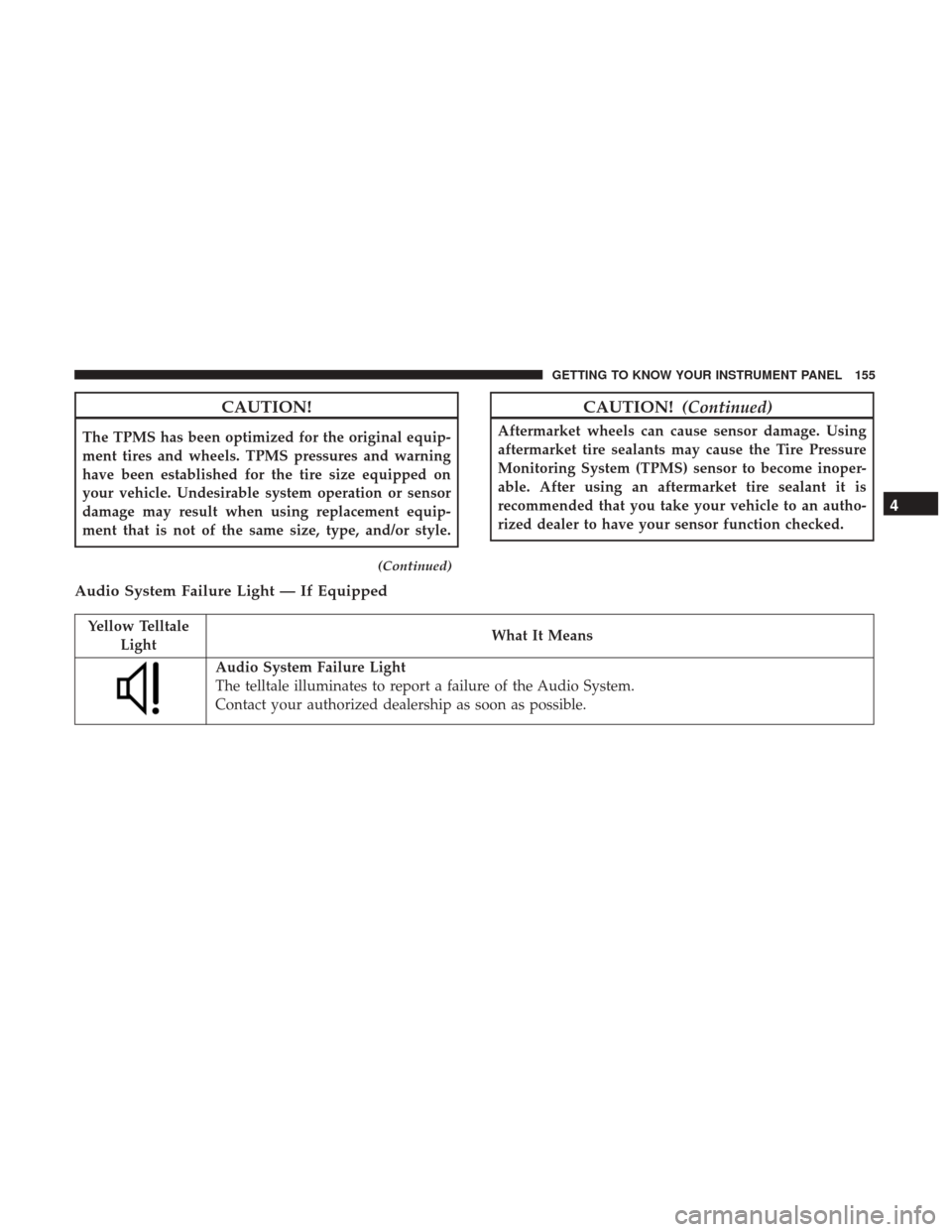
CAUTION!
The TPMS has been optimized for the original equip-
ment tires and wheels. TPMS pressures and warning
have been established for the tire size equipped on
your vehicle. Undesirable system operation or sensor
damage may result when using replacement equip-
ment that is not of the same size, type, and/or style.
(Continued)
CAUTION!(Continued)
Aftermarket wheels can cause sensor damage. Using
aftermarket tire sealants may cause the Tire Pressure
Monitoring System (TPMS) sensor to become inoper-
able. After using an aftermarket tire sealant it is
recommended that you take your vehicle to an autho-
rized dealer to have your sensor function checked.
Audio System Failure Light — If Equipped
Yellow Telltale
Light What It Means
Audio System Failure Light
The telltale illuminates to report a failure of the Audio System.
Contact your authorized dealership as soon as possible.
4
GETTING TO KNOW YOUR INSTRUMENT PANEL 155
Page 164 of 516
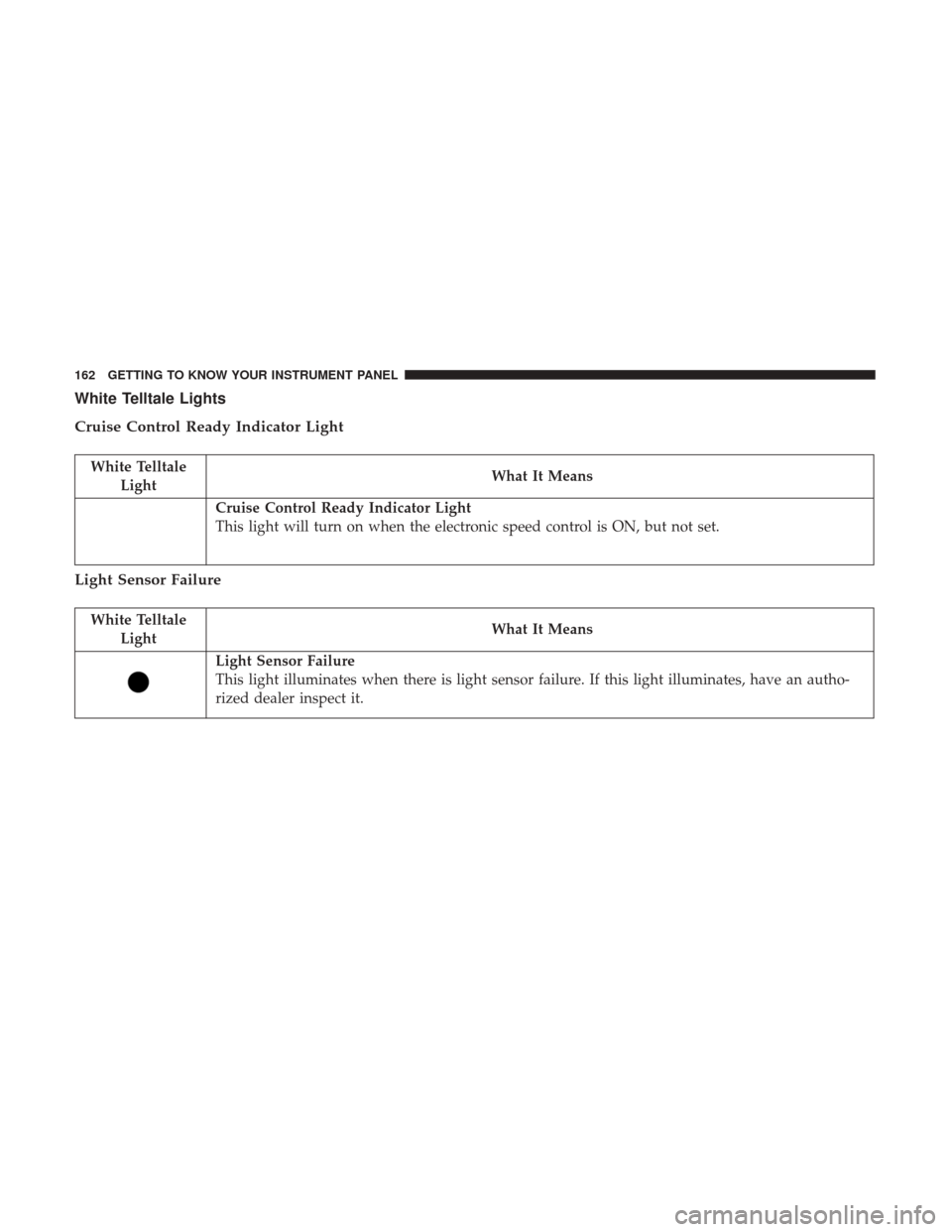
White Telltale Lights
Cruise Control Ready Indicator Light
White TelltaleLight What It Means
Cruise Control Ready Indicator Light
This light will turn on when the electronic speed control is ON, but not set.
Light Sensor Failure
White Telltale
Light What It Means
Light Sensor Failure
This light illuminates when there is light sensor failure. If this light illuminates, have an autho-
rized dealer inspect it.
162 GETTING TO KNOW YOUR INSTRUMENT PANEL
Page 173 of 516
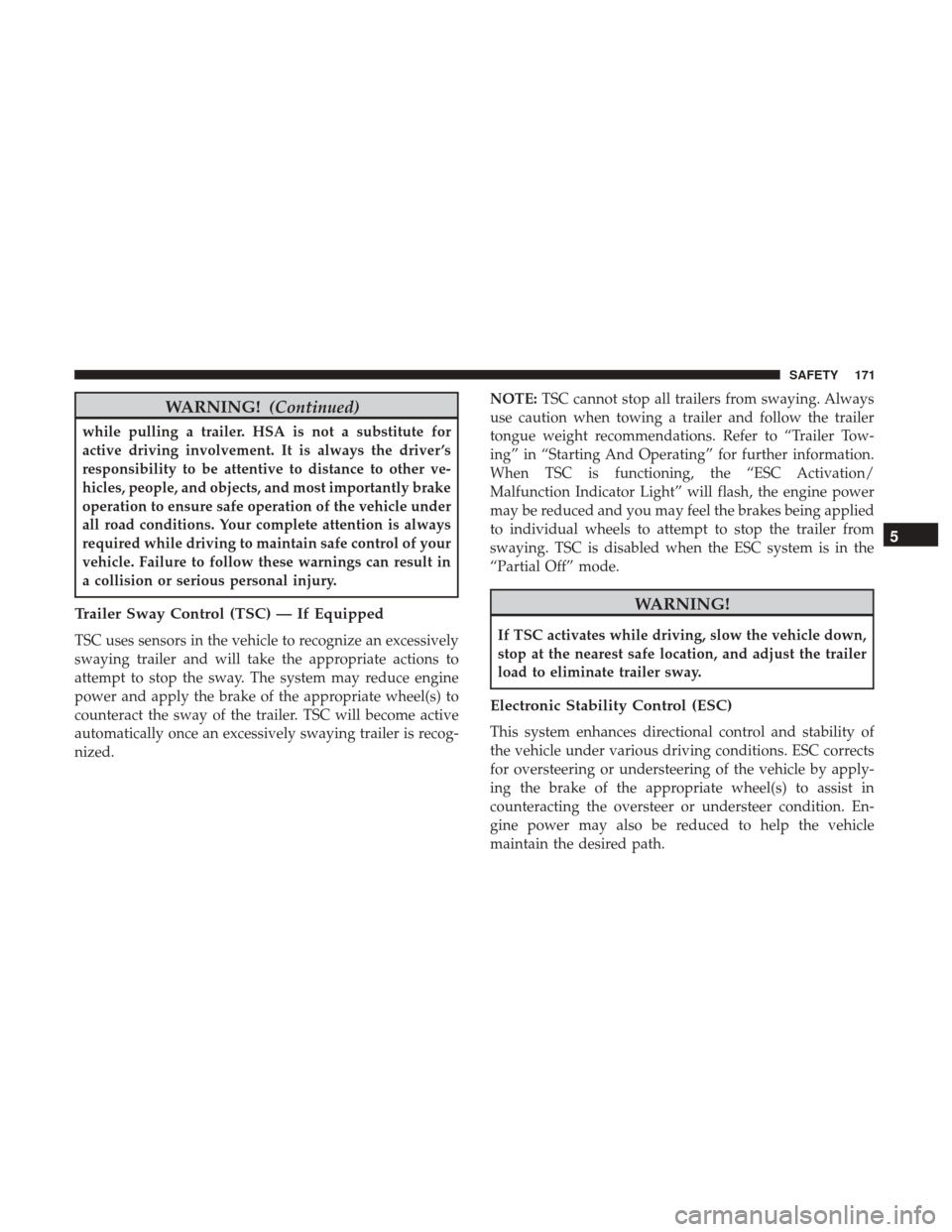
WARNING!(Continued)
while pulling a trailer. HSA is not a substitute for
active driving involvement. It is always the driver ’s
responsibility to be attentive to distance to other ve-
hicles, people, and objects, and most importantly brake
operation to ensure safe operation of the vehicle under
all road conditions. Your complete attention is always
required while driving to maintain safe control of your
vehicle. Failure to follow these warnings can result in
a collision or serious personal injury.
Trailer Sway Control (TSC) — If Equipped
TSC uses sensors in the vehicle to recognize an excessively
swaying trailer and will take the appropriate actions to
attempt to stop the sway. The system may reduce engine
power and apply the brake of the appropriate wheel(s) to
counteract the sway of the trailer. TSC will become active
automatically once an excessively swaying trailer is recog-
nized. NOTE:
TSC cannot stop all trailers from swaying. Always
use caution when towing a trailer and follow the trailer
tongue weight recommendations. Refer to “Trailer Tow-
ing” in “Starting And Operating” for further information.
When TSC is functioning, the “ESC Activation/
Malfunction Indicator Light” will flash, the engine power
may be reduced and you may feel the brakes being applied
to individual wheels to attempt to stop the trailer from
swaying. TSC is disabled when the ESC system is in the
“Partial Off” mode.
WARNING!
If TSC activates while driving, slow the vehicle down,
stop at the nearest safe location, and adjust the trailer
load to eliminate trailer sway.
Electronic Stability Control (ESC)
This system enhances directional control and stability of
the vehicle under various driving conditions. ESC corrects
for oversteering or understeering of the vehicle by apply-
ing the brake of the appropriate wheel(s) to assist in
counteracting the oversteer or understeer condition. En-
gine power may also be reduced to help the vehicle
maintain the desired path.
5
SAFETY 171
Page 174 of 516
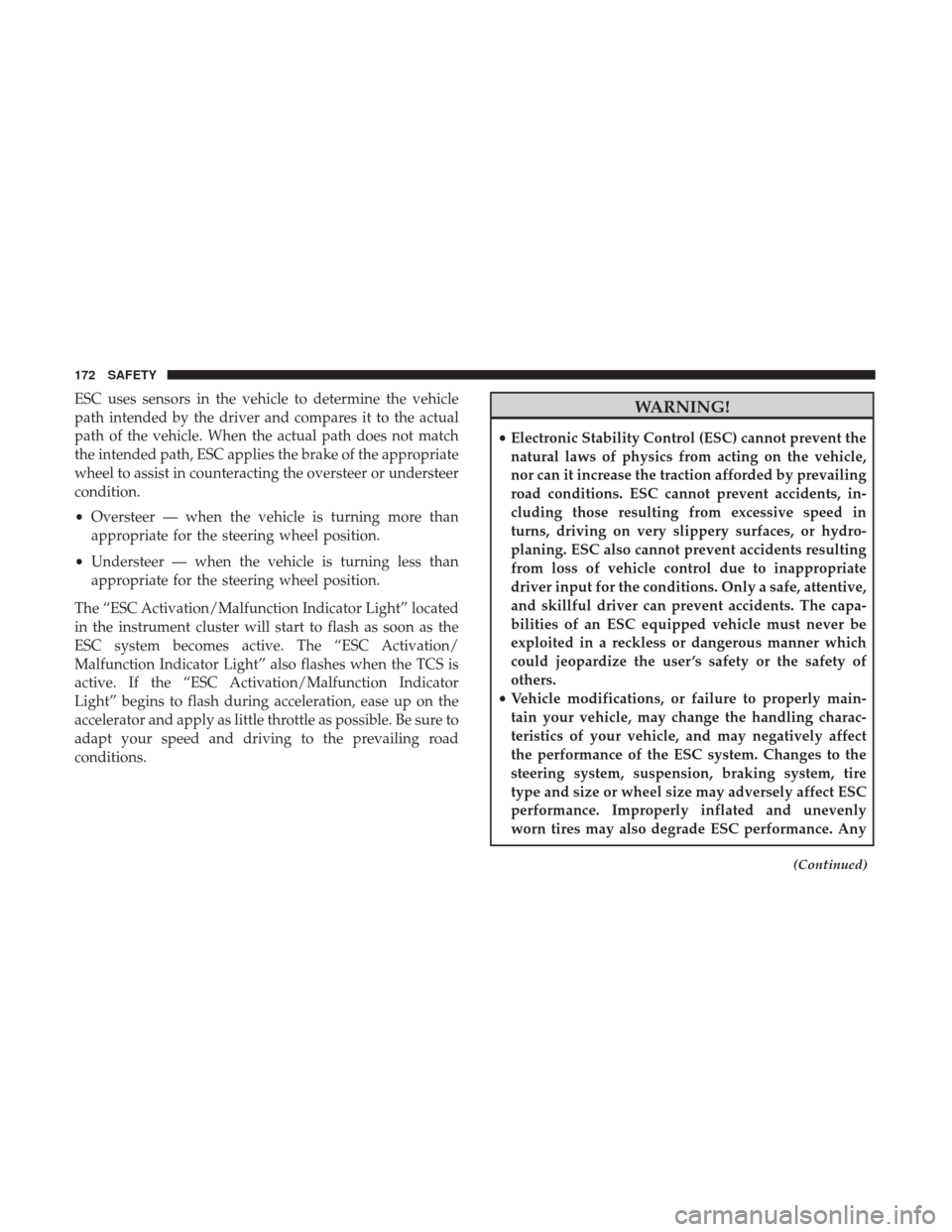
ESC uses sensors in the vehicle to determine the vehicle
path intended by the driver and compares it to the actual
path of the vehicle. When the actual path does not match
the intended path, ESC applies the brake of the appropriate
wheel to assist in counteracting the oversteer or understeer
condition.
•Oversteer — when the vehicle is turning more than
appropriate for the steering wheel position.
• Understeer — when the vehicle is turning less than
appropriate for the steering wheel position.
The “ESC Activation/Malfunction Indicator Light” located
in the instrument cluster will start to flash as soon as the
ESC system becomes active. The “ESC Activation/
Malfunction Indicator Light” also flashes when the TCS is
active. If the “ESC Activation/Malfunction Indicator
Light” begins to flash during acceleration, ease up on the
accelerator and apply as little throttle as possible. Be sure to
adapt your speed and driving to the prevailing road
conditions.WARNING!
• Electronic Stability Control (ESC) cannot prevent the
natural laws of physics from acting on the vehicle,
nor can it increase the traction afforded by prevailing
road conditions. ESC cannot prevent accidents, in-
cluding those resulting from excessive speed in
turns, driving on very slippery surfaces, or hydro-
planing. ESC also cannot prevent accidents resulting
from loss of vehicle control due to inappropriate
driver input for the conditions. Only a safe, attentive,
and skillful driver can prevent accidents. The capa-
bilities of an ESC equipped vehicle must never be
exploited in a reckless or dangerous manner which
could jeopardize the user ’s safety or the safety of
others.
• Vehicle modifications, or failure to properly main-
tain your vehicle, may change the handling charac-
teristics of your vehicle, and may negatively affect
the performance of the ESC system. Changes to the
steering system, suspension, braking system, tire
type and size or wheel size may adversely affect ESC
performance. Improperly inflated and unevenly
worn tires may also degrade ESC performance. Any
(Continued)
172 SAFETY